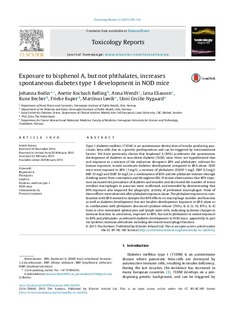| dc.contributor.author | Bodin, Johanna | |
| dc.contributor.author | Bølling, Anette Kocbach | |
| dc.contributor.author | Wendt, Anna | |
| dc.contributor.author | Eliasson, Lena | |
| dc.contributor.author | Becher, Rune | |
| dc.contributor.author | Kuper, Frieke | |
| dc.contributor.author | Løvik, Martinus | |
| dc.contributor.author | Nygaard, Unni Cecilie | |
| dc.date.accessioned | 2019-11-13T10:23:31Z | |
| dc.date.available | 2019-11-13T10:23:31Z | |
| dc.date.created | 2015-06-22T12:20:58Z | |
| dc.date.issued | 2015 | |
| dc.identifier.citation | Toxicology reports. 2015, 2 99-110. | nb_NO |
| dc.identifier.issn | 2214-7500 | |
| dc.identifier.uri | http://hdl.handle.net/11250/2628136 | |
| dc.description.abstract | Type 1 diabetes mellitus (T1DM) is an autoimmune destruction of insulin producing pancreatic beta-cells due to a genetic predisposition and can be triggered by environmental factors. We have previously shown that bisphenol A (BPA) accelerates the spontaneous development of diabetes in non-obese diabetic (NOD) mice. Here, we hypothesized that oral exposure to a mixture of the endocrine disruptors BPA and phthalates, relevant for human exposure, would accelerate diabetes development compared to BPA alone. NOD mice were exposed to BPA (1 mg/l), a mixture of phthalates (DEHP 1 mg/l, DBP 0.2 mg/l, BBP 10 mg/l and DiBP 20 mg/l) or a combination of BPA and the phthalate mixture through drinking water from conception and throughout life. Previous observations that BPA exposure increased the prevalence of diabetes and insulitis and decreased the number of tissue resident macrophages in pancreas were confirmed, and extended by demonstrating that BPA exposure also impaired the phagocytic activity of peritoneal macrophages. None of these effects were observed after phthalate exposure alone. The phthalate exposure in combination with BPA seemed to dampen the BPA effects on macrophage number and function as well as diabetes development, but not insulitis development. Exposure to BPA alone or in combination with phthalates decreased cytokine release (TNFα, IL-6, IL-10, IFNγ, IL-4) from in vitro stimulated splenocytes and lymph node cells, indicating systemic changes in immune function. In conclusion, exposure to BPA, but not to phthalates or mixed exposure to BPA and phthalates, accelerated diabetes development in NOD mice, apparently in part via systemic immune alterations including decreased macrophage function. | nb_NO |
| dc.language.iso | eng | nb_NO |
| dc.publisher | Elsevier | nb_NO |
| dc.rights | Attribution-NonCommercial-NoDerivatives 4.0 Internasjonal | * |
| dc.rights.uri | http://creativecommons.org/licenses/by-nc-nd/4.0/deed.no | * |
| dc.title | Exposure to bisphenol A, but not phthalates, increases spontaneous diabetes type 1 development in NOD mice | nb_NO |
| dc.type | Journal article | nb_NO |
| dc.type | Peer reviewed | nb_NO |
| dc.description.version | publishedVersion | nb_NO |
| dc.source.pagenumber | 99-110 | nb_NO |
| dc.source.volume | 2 | nb_NO |
| dc.source.journal | Toxicology reports | nb_NO |
| dc.identifier.doi | 10.1016/j.toxrep.2015.02.010 | |
| dc.identifier.cristin | 1249810 | |
| dc.description.localcode | © 2015 The Authors. Published by Elsevier Ireland Ltd. This is an open access article under the CC BY-NC-ND license (http://creativecommons.org/licenses/by-nc-nd/4.0/). | nb_NO |
| cristin.unitcode | 194,65,15,0 | |
| cristin.unitname | Institutt for klinisk og molekylær medisin | |
| cristin.ispublished | true | |
| cristin.fulltext | original | |
| cristin.qualitycode | 1 | |

